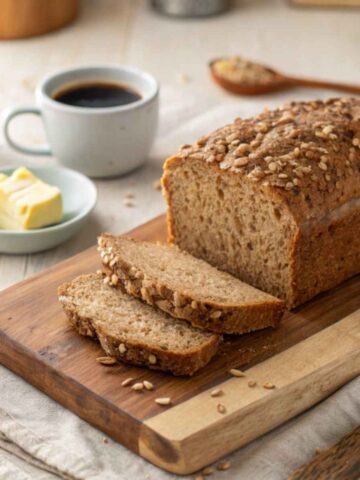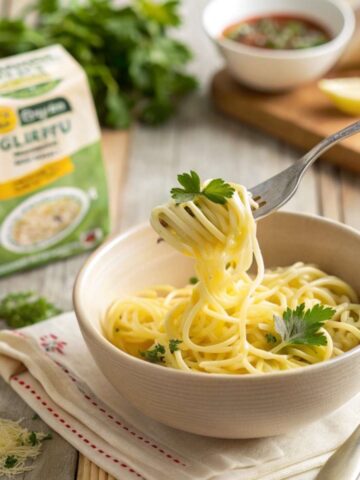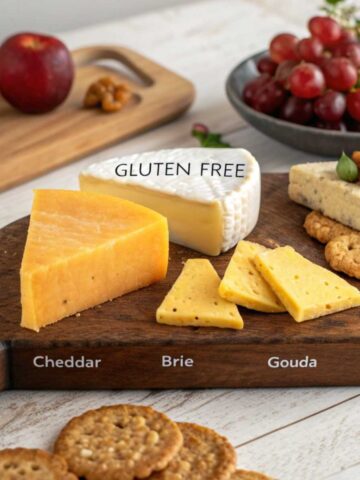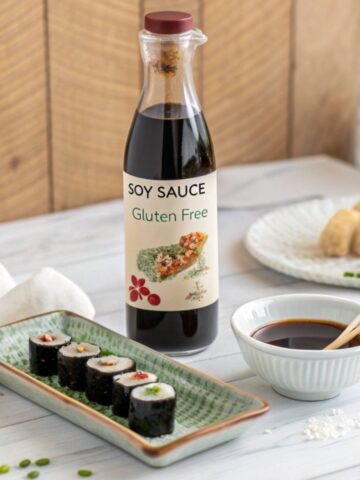When you think of a kitchen staple like cornstarch, it’s hard to imagine how such a simple ingredient could confuse anyone following a glutenfree diet. Cornstarch is a fine, powdery substance made from the starchy part of the corn kernel. It’s typically used to thicken sauces and soups and even to give baked goods a certain lightness. But the question arises: Is cornstarch gluten free?

Let’s start by understanding what cornstarch is. Cornstarch is made by grinding up the endosperm of corn kernels, removing the protein and fiber to leave behind pure starch. This means that cornstarch, by its very nature, is gluten-free. However, the issue comes when it’s processed or packaged in ways that introduce gluten. So, how do you know for sure?
Jump to:
- The Role of Cornstarch in Cooking and Baking
- What Is Gluten and Why It Matters?
- Is Cornstarch Naturally Gluten Free?
- Cornstarch and Cross-Contamination: What You Should Know
- The Difference Between Cornstarch and Corn Flour
- Common Brands
- Why Some Cornstarch Might Contain Gluten
- How to Use Cornstarch in a Gluten-Free Kitchen
- Is Modified Cornstarch GF?
- Can Cornstarch Be Harmful? Common Health Concerns
- DIY GF Cornstarch Substitutes for Home Cooks
- Reading Labels: Ensuring Your Cornstarch is Truly Gluten Free
- Gluten-Free Baking with Cornstarch: Tips and Tricks
- Conclusion:
- FAQs
The Role of Cornstarch in Cooking and Baking
Why Cornstarch Is Popular in Recipes
Cornstarch is a favorite among home cooks and professional chefs alike. It thickens liquids without altering the flavor, making it a popular choice for gravies, sauces, soups, and puddings. Cornstarch plays a different role in gluten-free baking, helping to lighten the texture of gluten-free flours like rice flour or almond flour, which can sometimes be dense.
Common Uses
For anyone on a gluten-free diet, cornstarch becomes even more valuable. GF recipes often use cornstarch as a thickening agent, especially when avoiding wheat flour. It helps mimic the texture of gluten-containing foods, making it a crucial ingredient in many gluten-free kitchens.
What Is Gluten and Why It Matters?
Defining Gluten: A Quick Recap
Wheat, barley, and rye contain gluten, a type of protein. It’s what gives bread its elastic texture and holds baked goods together. For most people, gluten is harmless. But for those with celiac disease or non-celiac gluten sensitivity, consuming gluten can lead to a host of digestive problems, including bloating, diarrhea, and nutrient malabsorption.
Gluten’s Impact on Those with Celiac Disease and Gluten Sensitivity
For individuals with celiac disease, the smallest amount of gluten can trigger an immune response that damages the small intestine's lining. This is why avoiding even trace amounts of gluten is so important. For those with gluten sensitivity, the effects might not be as severe. However, gluten can still cause discomfort and health issues, making avoiding gluten or contaminated foods essential.
Is Cornstarch Naturally Gluten Free?
The Basics: Corn and Its Gluten-Free Nature
Corn, in its natural form, does not contain gluten. Cornstarch and other corn-derived products remain gluten-free unless manufacturers add gluten-containing ingredients during processing
Cornstarch Ingredients: What to Watch For
Pure cornstarch is made solely from corn, so it should be gluten-free. However, some brands might process cornstarch in facilities that handle gluten-containing products, leading to potential contamination. This is why it’s essential to choose brands that are certified gluten-free.
Cornstarch and Cross-Contamination: What You Should Know
Manufacturing Risks for Gluten Contamination
Cornstarch can be made in facilities that produce wheat flour or other gluten-containing products. Cross-contamination can happen when the same equipment is used for processing without proper cleaning between batches. Even trace amounts of gluten can pose a risk for individuals with celiac disease.
The Importance of Gluten-Free Cornstarch
To avoid any risk of gluten exposure, looking for certified gluten-free cornstarch is essential. Certification ensures that the product has been tested and contains less than 20 ppm (parts per million) of gluten, which is the FDA threshold for labeling a product gluten-free.
The Difference Between Cornstarch and Corn Flour
Cornstarch vs. Corn Flour: What Sets Them Apart
People often confuse cornstarch with corn flour, but they are two distinct products. Cornstarch is made from the starchy part of the corn kernel, while corn flour is made from the entire kernel, including protein, fiber, and starch. Corn flour is coarser and is often used in baking, while cornstarch is finer and typically used for thickening.
Is Corn Flour Gluten Free?
Like cornstarch, corn flour is naturally gluten-free. However, as with cornstarch, cross-contamination can occur if processed in the same facility as gluten-containing grains. Always check the packaging for a gluten-free label if you use corn flour in a gluten-free recipe.
Common Brands
If you're looking for gluten-free cornstarch, there are several trusted brands available:
Argo Cornstarch
One of the most popular brands in the U.S., Argo Cornstarch is labeled gluten-free and is a staple in many kitchens for its high quality and reliability.
Bob’s Red Mill Cornstarch
Known for its commitment to gluten-free products, Bob’s Red Mill offers certified GF cornstarch. They take extra precautions to avoid cross-contamination, making it a safe choice for those with celiac disease.
Clabber Girl Cornstarch
Another well-known brand, Clabber Girl, offers GF cornstarch for cooking and baking. It’s widely available and trusted by gluten-sensitive consumers.
Why Some Cornstarch Might Contain Gluten
Cross-Contamination in Processing Facilities
Even though cornstarch should be naturally gf, it can pick up gluten during processing if made in the same facility as wheat products. This is why choosing certified gluten-free products is essential if you have celiac disease or gluten intolerance.
Additives or Processing Agents That May Introduce Gluten
In some rare cases, cornstarch might
Manufacturers may add gluten-containing additives or preservatives, so always read the label thoroughly to ensure it contains no gluten.
How to Use Cornstarch in a Gluten-Free Kitchen
Gluten-Free Thickening Agents for Sauces and Soups
Cornstarch is an excellent thickening agent for sauces, gravies, and soups in gf cooking.Chefs often substitute it for flour-based roux to create a glossy finish and smooth texture while avoiding gluten contamination.
Using Cornstarch in Baking Without Gluten
Cornstarch can also be used in gluten-free baking to help create light, tender cakes and pastries. Gluten-free bakers often combine it with other flours to improve texture, as gluten-free flours tend to be dense. Adding cornstarch can lighten the texture and improve the structure of baked goods.
Some Alternatives
Tthese are the options can provide the same thickening effect:
1 Tapioca Starch
Manufacturers derive tapioca starch from the cassava root, making it a common substitute for cornstarch. It has a similar thickening power and works well in soups, sauces, and gluten-free baking.
2 Potato Starch
Another good alternative is potato starch, which offers excellent thickening properties. Bakers and cooks commonly use it in gluten-free recipes for its smooth texture and neutral flavor.
3 Arrowroot Powder
Arrowroot powder is another starch that can replace cornstarch in many recipes. It’s gluten- and grain-free, ideal for those who avoid gluten and corn.
Is Modified Cornstarch GF?
Understanding What Modified Cornstarch Is
Modified cornstarch has been chemically or physically altered to improve its performance in specific recipes, such as making sauces more stable or increasing shelf life. This process does not inherently add gluten, but the source of the modification could introduce gluten if it comes from wheat.
Potential Sources of Gluten in Modified Cornstarch
While modified cornstarch is often gluten-free, checking the label is essential. If the modification process involves wheat or barley, it may be unsafe for those avoiding gluten.
Can Cornstarch Be Harmful? Common Health Concerns
Nutritional Value of Cornstarch
Cornstarch is primarily a source of carbohydrates and provides little nutritional value in terms of vitamins or minerals. People often use it as a thickener instead of a nutritional ingredient. Arrowroot powder or tapioca starch may offer more nutritional benefits for those seeking a healthier alternative.
Health Risks with Overuse of Cornstarch
Although cornstarch is generally safe in small amounts, consuming too much can lead to blood sugar spikes due to its high glycemic index. It’s also low in fiber and may not be the best choice for individuals looking to maintain stable blood sugar levels.
DIY GF Cornstarch Substitutes for Home Cooks
If you run out of cornstarch or prefer not to use it, there are several DIY substitutes you can try:
How to Make Your Gluten-Free Thickening Agents
Mix equal parts of rice flour and tapioca starch to create a homemade gluten-free thickening agent. Most recipes use This mixture instead of cornstarch, providing the same thickening power without gluten.
Substituting Cornstarch in Gluten-Free Recipes
You can use an equal amount of arrowroot, potato, or tapioca starch when substituting cornstarch in gluten-free recipes. All these alternatives are gluten-free and perform well in recipes that require cornstarch.
Reading Labels: Ensuring Your Cornstarch is Truly Gluten Free
What to Look For on Packaging
When buying cornstarch, look for the gluten-free certification label. This confirms the product has undergone testing and complies with the FDA’s gluten-free standards.
How to Avoid Gluten Contamination in Your Pantry
Store your gluten-free cornstarch in an airtight container and keep it separate from any other gluten-containing flour in your pantry. This will help avoid any cross-contamination that could occur if gluten particles transfer between products.
Gluten-Free Baking with Cornstarch: Tips and Tricks
How Cornstarch Affects Texture and Moisture in Gluten-Free Baking
Many gluten-free baked goods rely on cornstarch to achieve a lighter, fluffier texture. Combined with gluten-free flour like rice flour or almond flour, it can prevent baked goods from becoming too dense.
Pairing Cornstarch with Other Gluten-Free Flours for Best Results
For the best results in gf baking, try combining cornstarch with other flour like sorghum, rice, or coconut flour. Cornstarch helps balance out the texture, making cakes, cookies, and bread less heavy and more enjoyable.
Conclusion:
The answer to “Is cornstarch gluten free?” is generally yes. Cornstarch, when made from 100% corn, is naturally gf. However, being cautious about cross-contamination during processing and packaging is essential. By choosing certified gluten-free brands, you can ensure your cornstarch is safe for gluten-sensitive individuals and those with celiac disease.
Cornstarch is a versatile and valuable ingredient in gluten-free cooking and baking. It thickens sauces, soups, and gravies without relying on gluten-containing products. Whether whipping a batch of gf cookies or preparing a creamy soup, cornstarch is essential in the gluten-free kitchen.
FAQs
Yes, cornstarch is naturally gluten-free because it comes from corn. However, cross-contamination can occur during processing, so always check for a gluten-free label.
Absolutely! Bakers often use cornstarch in gluten-free recipes to lighten textures and enhance the structure of baked goods.
Look for the gluten-free certification on the packaging. This guarantees the product has been tested and complies with gluten-free standards.
Some great substitutes include tapioca starch, potato starch, and arrowroot powder. These options are all gluten-free and work well in most recipes.
Always check the label to confirm that manufacturers used only gf ingredients when modifying cornstarch.





Leave a Reply